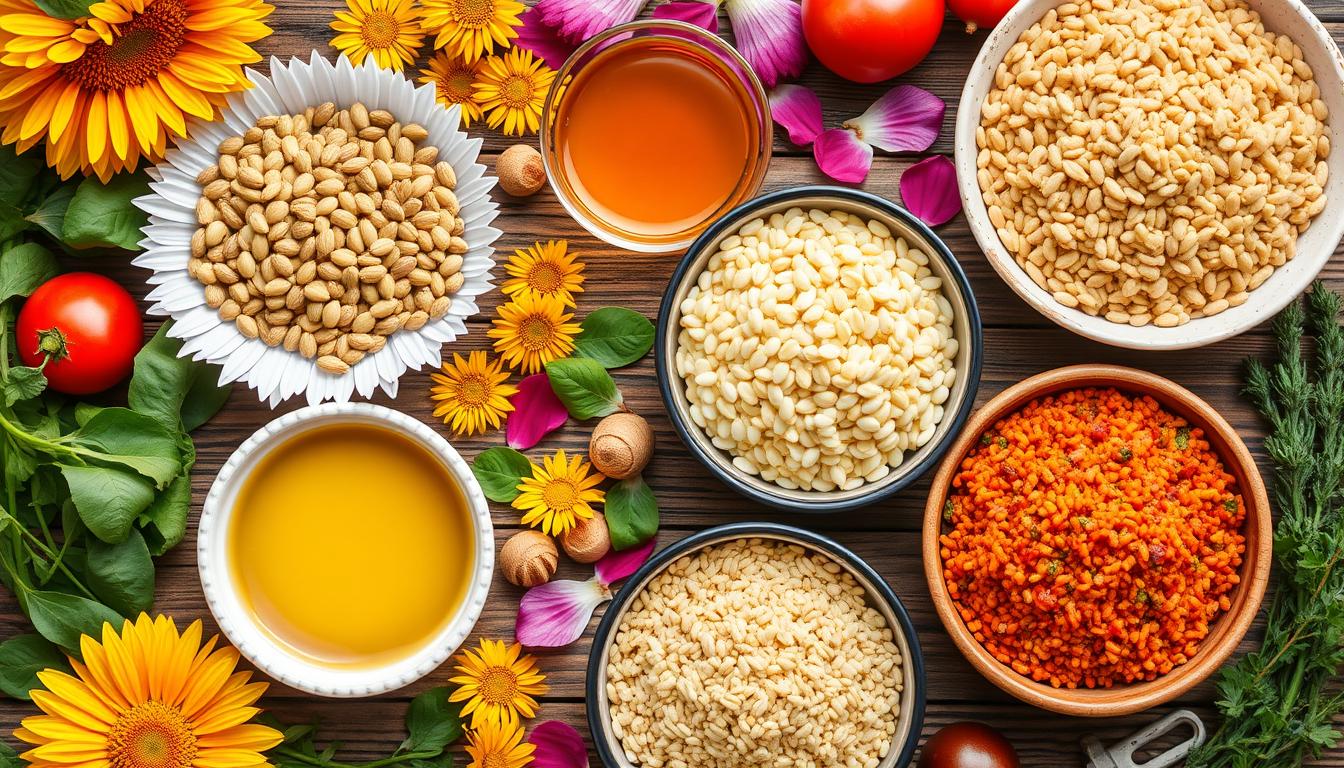Safflower Food: Nutritious and Versatile Superfood
When I opened the jar of safflower seeds, a strong aroma filled the air. It was earthy and nutty, making me excited to try it. Safflower is now seen as more than just a saffron substitute. It’s a nutrient-rich superfood loaded with health benefits.
Safflower has become popular in the world of healthy eating. It’s a favorite among those who want to eat well and enjoy it. This article will show you why safflower is so special. We’ll look at its nutrients, uses in cooking, and health benefits.
Table of Contents
Introduction to Safflower Food
Safflower is a plant that’s catching the eye of health lovers everywhere. Its bright yellow, orange, or red flowers have been grown for centuries. People are now seeing it as a superfood because it’s nutritious and versatile.
What is Safflower and Why is it Gaining Popularity?
Safflower, or Carthamus tinctorius, is a hardy plant that can handle dry weather. It can grow up to 150 cm tall. Each branch can have up to five flower heads, each with 15 to 20 seeds.
Its seeds are packed with good fats and vitamins. This makes safflower a great choice for those looking for healthy, plant-based foods. It’s not just good for you, but also adds flavor to dishes.
“Safflower is gaining popularity as a superfood due to its impressive nutritional profile, which includes a variety of essential vitamins, minerals, and healthy fats.”
Nutritional Profile of Safflower
Safflower is a nutritional powerhouse, packed with essential vitamins, minerals, and healthy fats. The seeds are high in monounsaturated and polyunsaturated fatty acids. They also contain dietary fiber, protein, and vitamins like E and K, along with minerals like calcium, iron, and magnesium.
Essential Nutrients Found in Safflower
These nutrients support overall health and well-being. Safflower is a valuable addition to a balanced diet. Here’s a closer look at the key nutrients found in safflower:
- Healthy Fats: Safflower is an excellent source of both monounsaturated and polyunsaturated fatty acids. These can help lower LDL (bad) cholesterol and raise HDL (good) cholesterol levels.
- Vitamin E: Safflower is rich in vitamin E, an antioxidant that supports immune function. It may also help prevent coronary heart disease.
- Vitamin K: Safflower contains vitamin K, which is essential for blood clotting and bone health.
- Minerals: Safflower is a good source of minerals like calcium, iron, and magnesium. These minerals are crucial for maintaining strong bones, regulating blood pressure, and supporting energy production.
- Dietary Fiber: The high fiber content in safflower can promote healthy digestion. It helps you feel full for longer.
- Protein: Safflower seeds are a source of plant-based protein. They make a nutritious addition to both vegetarian and vegan diets.
With its well-rounded nutritional profile, safflower is considered a superfood. Adding this versatile ingredient to your diet can provide many health benefits.
Health Benefits of Safflower Food
Eating safflower food can bring many health benefits. It’s full of healthy fats like oleic acid and linoleic acid. These fats help keep your heart healthy by improving cholesterol levels and lowering heart disease risk.
Safflower also has antioxidants and anti-inflammatory compounds. These can help lower body inflammation, which is linked to many chronic diseases. Plus, its fiber and protein can make you feel full and support digestion, helping with weight control.
- Promotes heart health by enhancing cholesterol levels and lowering the risk of heart disease.
- Helps reduce inflammation in the body, which is associated with chronic health conditions.
- Promotes feelings of fullness and supports healthy digestion, potentially aiding in weight management
Safflower’s safflower health benefits, safflower nutritional benefits, and safflower wellness make it great for a healthy diet.
“Safflower is a versatile and nutritious superfood that can provide a range of health benefits, from supporting heart health to reducing inflammation and promoting weight management.” – Nutrition Expert
safflower food: Culinary Uses and Recipes
Versatile Ways to Incorporate Safflower into Your Diet
Safflower food is very versatile. You can enjoy safflower seeds as a snack or add them to various dishes. They’re great in salads, yogurt, oatmeal, and baked goods.
Safflower oil is also a hit in the kitchen. It has a high smoke point, making it ideal for sautéing and deep-frying. You can use it for cooking without worrying about it burning or affecting the taste.
Moreover, you can grind safflower into flour. This flour is perfect for gluten-free or low-carb baking. It has a mild, nutty flavor that complements many ingredients.
| Oil | Smoke Point | Best Uses |
|---|---|---|
| Safflower Oil | 510°F (266°C) | High-heat cooking, sautéing, deep-frying |
| Avocado Oil | 400°F (204°C) | Sautéing, dressings, dips |
| Extra-virgin Olive Oil | 325°F (163°C) | Salad dressings, dipping bread |
| Grapeseed Oil | 425°F (218°C) | Baking, high-heat sautéing |
| Peanut Oil | 450°F (232°C) | Deep frying, stir-fries |
Adding safflower to your diet opens up many culinary uses. You can explore safflower recipes and ways to use safflower in your cooking. Its versatility makes it an excellent choice for maintaining a healthy lifestyle.

Safflower Oil: A Healthy Cooking Option
Safflower oil is a great choice for cooking. It has a high smoke point of about 450°F (232°C). This makes it perfect for frying, sautéing, and baking.
It’s also good for high-heat tasks like searing and roasting. This versatility makes it a favorite in many kitchens.
Safflower oil is also good for your health. It’s low in saturated fat and rich in healthy fats. These fats can help your heart by improving cholesterol levels.
It also has vitamin E, a strong antioxidant. Vitamin E helps protect your body from damage caused by free radicals.
When picking safflower oil, choose high-quality, unrefined or cold-pressed options. These oils are less processed. They keep more of their natural nutrients and flavor.
By choosing a high-quality safflower oil, you get the most nutritional benefits. You also get a better taste in your cooking.
| Oil | Smoke Point | Suitable Cooking Methods |
|---|---|---|
| Safflower oil | 450°F (232°C) | Frying, sautéing, baking, roasting, searing |
| Canola oil | 400°F (204°C) | Sautéing, grilling, frying, deep-frying |
| Avocado oil | 520°F (271°C) | Searing, grilling, stir-frying |
| Sunflower oil | 450°F (232°C) | Searing, sautéing, roasting, grilling, frying, deep-frying |
| Olive oil | 320-376°F (160-191°C) | Sautéing, baking, salad dressings, sauces |
In conclusion, safflower oil is a healthy and versatile cooking option. It can make your cooking better and more nutritious. Whether you’re searing, sautéing, or baking, safflower oil is a great choice.
Selecting and Storing Safflower Products
Tips for Choosing High-Quality Safflower Foods
When looking for safflower products, choose high-quality ones for the best nutrition. Opt for safflower seeds or safflower oil that are organic and non-GMO. Make sure they are minimally processed.
Stay away from products with added oils, sugars, or other ingredients. These can harm the safflower’s purity and quality.
Keeping safflower products fresh and nutritious is key. Store safflower seeds and oil in a cool, dark spot. This keeps them away from sunlight and heat.
With the right storage, safflower products can last up to a year. This means you can enjoy their health benefits for a long time.
| Safflower Oil | Sunflower Oil |
|---|---|
| Smoke point: 450°F (232°C) | Smoke point: 440°F (227°C) |
| High in linoleic acid (omega-6) | Varying proportions of oleic and linoleic acids |
| Beneficial for managing blood sugar and reducing inflammation | Supports skin health and immune function due to high vitamin E |
| Slightly better for high-heat cooking | Excellent for baking and as a base for dressings and sauces |
| Tends to be more expensive | More widely available and affordable |
Choosing top-notch safflower products and storing them right is key. This way, you get the most from this superfood. Add safflower to your meals for its health perks and versatility.

Potential Risks and Precautions
Safflower is usually safe for most people. But, there are some safflower risks and safflower precautions to know. If you’re allergic to flowers or plants in the Asteraceae family, like safflower, you might react to it.
Also, if you’re on blood-thinning meds, talk to your doctor first. Safflower has a lot of vitamin K, which could affect these medicines. Always start with a little and watch for any bad safflower safety reactions.
| Potential Risks | Precautions |
|---|---|
| Allergic reactions for those with Asteraceae family allergies | Consult with healthcare provider if taking blood-thinning medications |
| Potential interaction with high vitamin K content | Start with small amounts and monitor for adverse reactions |
Knowing these safflower risks and safflower precautions helps you enjoy safflower safely and healthily.
Safflower vs. Other Superfoods
Safflower is often compared to other superfoods because of its great nutritional value. It has a lot of healthy fats like oleic acid and linoleic acid. It also has a lot of dietary fiber, protein, and vitamins and minerals. This makes it an ideal option for a healthy diet.
How Safflower Compares to Other Nutrient-Dense Foods
Each superfood has its own benefits. But safflower stands out because of its mix of nutrients and its use in cooking. It’s a good choice for adding more nutrients to your diet.
| Nutrient | Safflower | Chia Seeds | Flaxseeds | Quinoa |
|---|---|---|---|---|
| Calories (per 100g) | 534 | 486 | 534 | 368 |
| Total Fat (g) | 51.5 | 31.0 | 42.2 | 6.1 |
| Protein (g) | 17.7 | 16.5 | 18.3 | 14.1 |
| Fiber (g) | 11.5 | 34.4 | 27.3 | 7.0 |
| Vitamin C (mg) | 0 | 0 | 0 | 0 |
| Calcium (mg) | 78 | 631 | 277 | 47 |
This comparison shows safflower is a strong contender among superfoods. It offers a unique mix of nutrients that can improve your health. It’s a good choice for boosting healthy fats, fiber, and vitamins and minerals in your diet.

Adding safflower to your diet, along with other nutrient-rich foods, can help you meet your nutritional needs. It supports a healthy and balanced lifestyle.
Conclusion
Safflower is a superfood that should be in every healthy kitchen. Its seeds and oil are packed with nutrients. They help keep your heart healthy and boost your overall well-being.
Looking to eat more nutritious foods? Want to try new recipes? Safflower is a great choice. It’s perfect for adding healthy oil to your cooking.
Learning about safflower’s nutritional benefits and uses opens up a world of possibilities. It’s full of antioxidants and may help with blood flow and diabetes. The research keeps showing how valuable safflower is for our health.
Starting to use safflower in your cooking can be exciting. Try safflower oil in your dishes and use safflower seeds in recipes. You’ll enjoy the flavors and colors it adds to your meals.
With safflower in your kitchen, you’re on the path to a healthier lifestyle. It’s a key to making your meals more nutritious and delicious.
FAQ
What is safflower and why is it gaining popularity?
Safflower is a plant that has been grown for centuries. It’s known for its oil and seeds. The plant’s bright flowers and seeds are packed with nutrients.
People are starting to see safflower as a superfood. It’s rich in vitamins, minerals, and healthy fats.
What are the key nutrients found in safflower?
Safflower is full of good stuff. It has healthy fats like oleic acid and linoleic acid. It’s also rich in dietary fiber, protein, and vitamins like E and K.
It has minerals like calcium, iron, and magnesium too.
What are the health benefits of consuming safflower food?
Eating safflower can help your heart. The healthy fats in it can improve cholesterol levels. This can lower the risk of heart disease.
The antioxidants in safflower may also reduce inflammation. This can help with chronic health issues. Plus, safflower’s fiber and protein can help you feel full and aid digestion.
How can safflower be used in cooking and baking?
Safflower is great in many dishes. You can snack on the seeds or add them to salads and baked goods. It boosts the nutritional value of your meals.
Safflower oil is perfect for cooking. It has a high smoke point and a mild flavor. Use it for sautéing, roasting, or baking. You can also grind it into flour for gluten-free baking.
What are the benefits of using safflower oil for cooking?
Safflower oil is a healthy choice for cooking. It has a high smoke point, making it good for frying and baking. It’s low in saturated fat and high in healthy fats.
It also has vitamin E, which is an antioxidant. This can help protect against oxidative stress.







